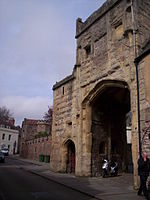Vicars' Close, Wells

Vicars' Close, in Wells, Somerset, England, is claimed to be the oldest purely residential street with original buildings surviving intact in Europe.John Julius Norwich called it "that rarest of survivals, a planned street of the mid-14th century". It comprises numerous Grade I listed buildings, comprising 27 residences (originally 44), built for Bishop Ralph of Shrewsbury, a chapel and library at the north end, and a hall at the south end, over an arched gate. It is connected at its southern end to the cathedral by a walkway over Chain Gate. The Close is about 460 feet (140 m) long, and paved with setts. Its width is tapered by 10 feet (3.0 m) to make it look longer when viewed from the main entrance nearest the cathedral. When viewed from the other end it looks shorter. By the nineteenth century the buildings were reported to be in a poor state of repair, and part of the hall was being used as a malt house. Repairs have since been carried out including the construction of Shrewsbury House to replace buildings damaged in a fire. The Vicars' Hall was completed in 1348 and included a communal dining room, administrative offices and treasury of the Vicars Choral. The houses on either side of the close were built in the 14th and early 15th centuries. Since then alterations have been made including a unified roof, front gardens and raised chimneys. The final part of the construction of the close was during the 1420s when the Vicars' Chapel and Library was constructed on the wall of the Liberty of St Andrew. The south face includes shields commemorating the bishops of the time. The interior is decorated with 19th-century gesso work by Heywood Sumner and the building now used by Wells Cathedral School.
Excerpt from the Wikipedia article Vicars' Close, Wells (License: CC BY-SA 3.0, Authors, Images).Vicars' Close, Wells
Vicars' Close, Wells
Geographical coordinates (GPS) Address External links Nearby Places Show on map
Geographical coordinates (GPS)
| Latitude | Longitude |
|---|---|
| N 51.2115 ° | E -2.6437 ° |
Address
Vicars' Close
Vicars' Close
BA5 2UN Wells
England, United Kingdom
Open on Google Maps










